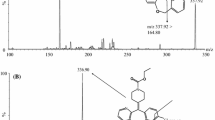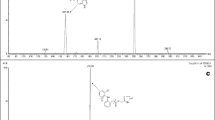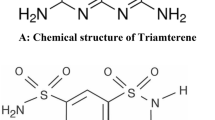Abstract
Liquid chromatography-tandem mass spectrometry (LC-MS/MS) and inductively coupled plasma-atomic emission spectroscopy (ICP-AES) methods were developed and validated for the evaluation of motexafin lutetium (MLu, lutetium texaphyrin, PCI-0123) pharmacokinetics in human plasma. The LC-MS/MS method was specific for MLu, whereas the ICP-AES method measured total elemental lutetium. Both methods were fast, simple, precise, and accurate. For the LC-MS/MS method, a closely related analogue (PCI-0353) was used as the internal standard (IS). MLu and the IS were extracted from plasma by protein precipitation and injected onto and LC-MS/MS system configured with a C18 column and an electrospray interface. The lower limit of quantitation was 0.05 μg MLu mL−1, with a signal-to-noise ratio of 15∶1. The response was linear from 0.05 to 5.0 μg MLu mL−1. For the ICP-AES method, indium was used as the IS. The sample was digested with nitric acid, diluted, filtered, and then injected onto the ICP-AES system. Two standard curve ranges were validated to meet the expected range of sample concentrations: 0.5 to 50, and 0.1 to 10 μg Lu mL−1. The LC-MS/MS and ICP-AES methods were validated to establish accuracy, precision, analyte stability, and assay robustness. Interday precision and accuracy of quality control samples were ≤6.3% coefficient of variation (CV) and within 2.2% relative error (RE) for the LC-MS/MS method, and ≤8.7% CV and within 4.9% RE for the ICP-AES method. Plasma samples from a subset of patients in a clinical study were analyzed using both methods. For a representative patient, over 90% of the elemental lutetium in plasma could be ascribed to intact MLu at early time points. This percentage decreased to 59% at 48 hours after dosing, suggesting that some degradation and/or metabolism of the drug may have occurred.
Similar content being viewed by others
References
Sessler JL, Murai T, Lynch V, Cyr M. An “expanded porphyrin”: the synthesis and structure of a new aromatic pentadentate ligand. J Am Chem Soc. 1988;110:5586–5588.
Mody TD, Fu L, Sessler JL. Texaphyrins: synthesis and development of a novel class of therapeutic agents. In: Karlin KD, ed. Progress in Inorganic Chemistry. New York, NY: John Wiley & Sons; 2001:551–598.
Sessler JL, Mody TD, Hemmi GW, Lynch V. Synthesis and structural characterization of lanthanide(III) texaphyrins. Inorg Chem. 1993;32:3175–3187.
Sessler JL, Hemmi G, Mody TD, Murai T, Burrell A, Young S. Texaphyrins: synthesis and applications. Acc Chem Res. 1994;27:43–50.
Mody TD, Sessler JL. Porphyrin- and expanded porphyrin-based diagnostic and therapeutic agents. In: Reinhoudt DN, ed. Supramolecular Technology. New York, NY: John Wiley & Sons; 1999:245–294.
Young SW, Woodburn KW, Wright M, et al. Lutetium texaphyrin (PCI-0123): a near-infrared, water-soluble photosensitizer. Photochem Photobiol. 1996;63:892–897.
Guldi DM, Mody TD, Gerasimchuk N, Magda D, Sessler JL. Influence of large metal cations on the photophysical properties of texaphyrin, a rigid aromatic chromophore. Am Chem Soc. 2000;122:8289–8298.
Grossweiner LI, Bilgin MD, Berdusis P, Mody TD. Singlet oxygen generation by metallotexaphyrins. Photochem Photobiol. 1999;70:138–145.
Sessler JL, Dow WC, O Connor D, et al. Biomedical applications of lanthanide (III) texaphyrins: Lutetium (III) texaphyrins as potential photodynamic therapy photosensitizers. J Alloys Compounds. 1997;249:146–152.
Harriman A, Maiya BG, Murai T, Hemmi G, Sessler JL, Mallouk TE. Metallotexaphyrins: a new family of photosensitizers for efficient generation of singlet oxygen. J Chem Soc Chem Commun. 1989;5:314–316.
Rockson SG, Lorenz DP, Cheong W, Woodburn KW. Photoangioplasty: an emerging clinical cardiovascular role for photodynamic therapy. Circulation. 2000;102:591–596.
Lum B, Wieman JT, Taber S, et al. Pharmacokinetics of lutetium texaphyrin (Lu-Tex) in a phase I trial of photodynamic therapy (PDT) of cancer (Clinical Pharmacology). Proc Annu Meet Am Soc Clin Oncol. 1997;16:A243.
Renschler MF, Yuen A, Panella TJ, et al. Photodynamic therapy trials with lutetium texaphyrin (Lu-Tex) in patients with locally recurrent breast cancer. Proc Optimal Methods Tumor Treatment Detect: Mech Tech Photodynam Ther VII. SPIE. 1998;3247:35–39.
Wieman TJ, Panella T, Lustig R, et al. Photodynamic therapy (PDT) of locally recurrent breast cancer (LRBC) with lutetium texaphyrin (Lutrin): a phase IB/IIA trial. Proc ASCO. 1999;18:a111.
Kereiakes DJ, Szyniszewski AM, Simon DI, et al. Coronary photoangioplasty using motexafin lutetium (Antrin®): early findings of a phase I safety trial in patients undergoing stent implantation. Circulation. 2000;102:565–565.
Rockson SG, Kramer P, Razavi M, et al. Photoangioplasty for human peripheral atherosclerosis: results of a phase I trial of photodynamic therapy with motexafin lutetium (Antrin). Circulation. 2000;102:2322–2324.
Sessler JL, Miller RA. Texaphyrins: new drugs with diverse clinical applications in radiation and photodynamic therapy. Biochem Pharmacol. 2000;59:733–739.
Woodburn KW, Fan Q, Kessel D, Luo Y, Young SW. Photodynamic therapy of B16F10 murine melanoma with lutetium texaphyrin. J Invest Dermatol. 1998;110:746–751.
Woodburn K, Qing F, Kessel D, Young S. Photoeradication and imaging of atheromatous plaque with texaphyrins. Proc Lasers Surg: Adv Characteriz, Ther, Sys VII. SPIE. 1997,2970:44–50.
Woodburn KW, Young SW, Fan Q, Kessel D, Miller RA. Selective uptake of texaphyrins by atheromatous plaque. Proc Lasers Surg: Adv Characteriz, Ther, Sys VI. SPIE. 1996;2671:62–71.
Woodburn KW, Fan Q, Miles DR, Kessel D, Luo Y, Young SW. Localization and efficacy analysis of the phototherapeutic lutetium texaphyrin (PCI-0123) in the murine EMT6 sarcoma model. Photochem Photobiol. 1997;65:410–415.
Parise RA, Miles DR, Egorin MJ. Sensitive high-performance liquid chromatographic assay for motexafin gadolinium and motexafin lutetium in human plasma. J Chromatogr. 2000;749:145–152.
Normann PT, Joffe P, Martinsen I, Thomsen HS. Quantification of gadodiamide as Gd in serum, peritoneal dialysate and faeces by inductively coupled plasma atomic emission spectroscopy and comparative analysis by high-performance liquid chromatography. J Pharm Biomed Anal. 2000;22:939–947.
Sessler JL, Tvermoes NA, Guldi DM, Mody TD, Allen WE. One-electron reduction and oxidation studies of the radiation sensitizer gadolinium(III) texaphyrin (PCI-0120) and other water soluble metallotexaphyrins. J Phys Chem. 1999;103:787–794.
Nachi R, Weng N, Lee JW, Hulse JD, Lin PP. Method improvements for LC/MS/MS bioanalysis of buprenorphine in human plasma. AAPS PharmSci. 1999; 1(suppl):S-303. Abstract 2809. Available at: http://www.aapspharmsci.org/abstracts/AM_1999/1140.htm.
Jiang X, Sartwell C, Petersen M, et al. A sensitive LC/MS/MS method for the quantitation of cyclosporin A in human blood. In: Proceedings the 46th ASMS Conference on Mass Spectrometry and Allied Topics. 1998:1459. Available at: http://www.inmerge.com/aspfolder/ASMSAbstracts.html, using cyclosporin in text search.
Kebarle P, Tang L. From ions in solution to ions in the gas phase: the mechanism of electrospray mass spectrometry. Anal Chem. 1993;65:972A-986A.
Matuszewski BK, Constanzer ML, Charez-Eng CM. Matrix effect in quantitative LC/MS/MS analyses of biological fluids: a method for determination of finasteride in human plasma at picogram per millilitre concentrations. Anal Chem. 1998;70:882–889.
King R, Bonfiglio R, Fernandez-Metzler C, Miller-Stein C, Olah T. Mechanistic investigation of ionisation suppression in electrospray ionisation. J Am Soc Mass Spectrom. 2000;11:942–950.
Shah VP, Midha KK, Dighe S, et al. Analytical methods validation: bioavailability, bioequivalence, and pharmacokinetic studies. J Pharm Sci. 1992;81:309–312.
Author information
Authors and Affiliations
Corresponding author
Additional information
Published: August 12, 2003
Rights and permissions
About this article
Cite this article
Miles, D., Mody, T.D., Hatcher, L.I. et al. Quantitation of motexafin lutetium in human plasma by liquid chromatography-tandem mass spectrometry and inductively coupled plasma-atomic emission spectroscopy. AAPS PharmSci 5, 23 (2003). https://doi.org/10.1208/ps050323
Received:
Accepted:
Published:
DOI: https://doi.org/10.1208/ps050323




